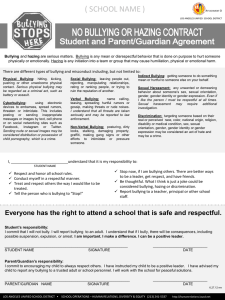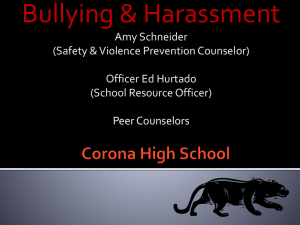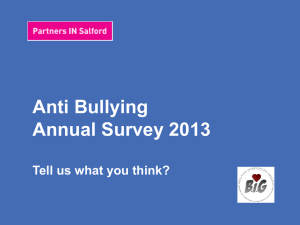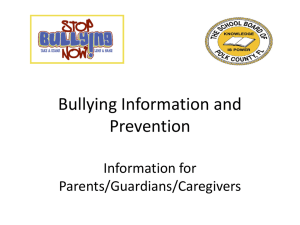Bully prevention and intervention & Threat assessment
advertisement
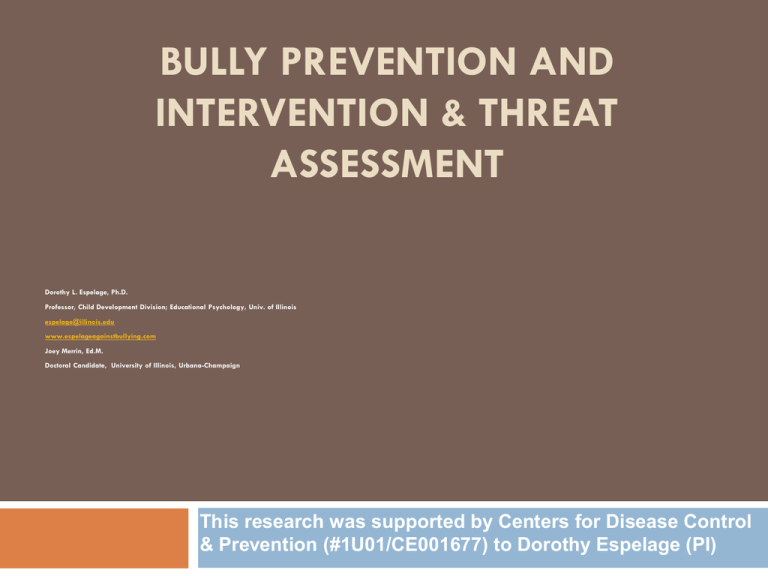
BULLY PREVENTION AND INTERVENTION & THREAT ASSESSMENT Dorothy L. Espelage, Ph.D. Professor, Child Development Division; Educational Psychology, Univ. of Illinois espelage@illinois.edu www.espelageagainstbullying.com Joey Merrin, Ed.M. Doctoral Candidate, University of Illinois, Urbana-Champaign This research was supported by Centers for Disease Control & Prevention (#1U01/CE001677) to Dorothy Espelage (PI) University of Illinois Anti-Bullying Program • Indiana University Teen Conflict Survey (Bosworth, Espelage, & Simon, 1999; Espelage et al., 2000, 2001) • ▫ University of Illinois Bullying Research Program ▫ INTERVIEW STUDY (Espelage & Asidao, 2001) ▫ EXPOSURE TO VIOLENCE STUDY (Espelage, 1998) ▫ SOCIAL NETWORK ANALYSIS STUDY (Espelage, Holt, & Henkel, 2003; Espelage, Green, & Wasserman, 2007; Espelage, Green, & Polanin, in press) ▫ SEXUAL HARASSMENT, DATING VIOLENCE, & BULLYING STUDIES (Holt & Espelage, 2003; Holt & Espelage, 2005; Espelage & Holt, 2006) ▫ ATTRIBUTION, COPING STYLES, & BULLYING (Kingsbury & Espelage, 2006) ▫ THEORY OF MIND, EMPATHY, & BULLYING (Espelage et al., 2004; Mayberry & Espelage, 2006) ▫ HOMOPHOBIA, SEXUAL VIOLENCE, & BULLYING (Poteat & Espelage, 2006; Espelage et al., 2008) ▫ Sexual Orientation, Bullying, & Mental Health Outcomes (Espelage, Aragon, Birkett, & Koenig, 2008; Poteat, Espelage, & Koenig, 2009; Birkett, Espelage, & Koenig, 2009) CDC Federally-funded Grants: ▫ Bullying & SV Overlap (2007 - 2010) ▫ Randomized Clinical Trial of Middle School Second Step Program (Committee for Children, 2008) in Reducing Bullying & SV (2009-2013) Evolutionary Insights Into Risky Adolescent Behavior (Ellis et al., 2011) Domain of Study Functions of risky and aggressive behavior Sample Insights • • • Both Prosocial and antisocial behavioral strategies function to control resources Bullying is a common animal behavior that increases access to physical, social, and sexual resources Adolescents are adapted to engage in bullying when the conditions are right Sample Implications for Intervention • • • Many antibullying interventions fail because they are based on false stereotypes about the social incompetence of bullies. Interventions need to alter the cost-benefit ratio of bullying so that it is no longer an adaptive strategy in the school ecology. Interventions should try to substitute more prosocial strategies that yield outcomes that are comparable to those achieved through bullying Evolutionary Insights Into Risky Adolescent Behavior (Ellis et al., 2011) Domain of Study Conditional adaptation to stressful environments Sample Insights • • Stressful experiences direct or regulate development toward strategies that are adaptive under stressful conditions Exposures to harsh and unpredictable environments each uniquely increase risky adolescent behavior Sample Implications for Intervention • • • Interventions should be careful of declawing the cat. Band-Aid solutions that do not address causative environmental conditions will not effectively change high-risk behaviors. Interventions need to alter social contexts in ways that--through changes in the experiences of at-risk-youth—induce an understanding that they can lead longer, healthier, more predictable lives. Definition of Bullying (Swearer, 2001) Bullying happens when someone hurts or scares another person on purpose and the person being bullied has a hard time defending himself or herself. Usually, bullying happens over and over. Punching, shoving and other acts that hurt people physically Spreading bad rumors about people Keeping certain people out of a “group” Teasing people in a mean way Getting certain people to “gang up” on others Use of technology Bully/Victim Continuum Bully – reports bullying others Victim – reports being bullied by others Bully-victim – reports bullying others & being bullied Bystander – reports observing others being bullied No Status/Not involved – does not report any involvement with bullying Bullying Prevalence Among 3rd – 8th graders: 15% Chronically Victimized 17% Ringleader Bullies 8% Bully-Victims 60% Bystanders Only 13% intervene to help victim (Espelage & Swearer, 2003) Cyber-Bullying “Cyber-bullying involves the use of information and communication technologies to support deliberate, repeated, and hostile behavior by an individual or group, that is intended to harm others." (Bill Belsey: www.cyberbullying.ca) http://www.in.com/videos/watchvideo-psa-oncyberbullying-from-the-national-crime-preventioncouncil-2398263.html Technology Use by Youth Most children and adolescents are online (93%) – but not all are (7% are not) Many (73%) are on Face book and other social network sites But very few (8%) are tweeting Constantly text messaging? YES 72% of teens text; at an average of 112 texts per day CyberBullying (Ybarra, 2012) Cyberbullying (bullying online) affects between 15-17% of youth each year; harassment affects about 38% • More than 4 in 5 youth who use the Internet are *not* cyberbullied About 1/3 of bullied and harassed youth are very or extremely upset • 2/3 bullied and harassed youth are less affected Bullying is most commonly an in-person experience (21% are bullied exclusively this way). • For a concerning minority (8%), bullying is ubiquitous (in person, online, via text) Internet victimization is not increasing • Text messaging victimization may be increasing… Bullying Prevention – Meta-analysis (Merrell et al., 2008) Evaluated effectiveness of 16 bullying efficacy studies across some six countries (six studies in US). Only two of six US studies published. All showed small to negligible effects. Small positive effects found for enhancing social competence and peer acceptance, and increasing teacher knowledge and efficacy in implementing interventions. Reality—No impact on bullying behaviors. Farrington & Tfoti (2009) – programs that are effective in European country include parents, use of multimedia, and target teacher’s competence in responding to bullying. Bullying Prevention –Why little success? Majority of the programs fail to recognize that bullying co-occurs with other types of aggression, including sexual violence, dating aggression, and homophobic banter. • Programs often fail to address basic life and social skills that kids may need to effectively respond to bullying. • Only one program directs prevention efforts at the key context that promotes and sustains bullying perpetration – the peer group. • No programs consider the impact of family and community violence on bullying prevalence . • • All programs fail to address the extent to which demographic variables (such as gender and race) and implementation levels impact a program’s effectiveness. 12 www. www.guilford.com Social-Ecological Perspective Society Community School Family Child /Peers (Bronfenbrenner, 1979; Swearer & Doll, 2001; Espelage & Swearer, 2003; Espelage & Horne, 2007) Individual Correlates of Bullying Involvement Depression/Anxiety Empathy Delinquency Impulsivity Other forms of Aggression Alcohol/Drug Use Positive Attitudes toward Violence/Bullying Low Value for Prosocial Behaviors For review (Espelage & Swearer, 2003; Espelage & Horne, 2007) Family & School Risk Factors FAMILY – Lack of supervision – Lack of attachment – Negative, critical relationships – Lack of discipline/ consequences – Support for violence – Modeling of violence SCHOOL – Lack of supervision – Lack of attachment – Negative, critical relationships – Lack of discipline/ consequences – Support for violence – Modeling of violence For review (Espelage & Swearer, 2003; Espelage & Horne, 2007) Sibling Bullying Sibling bullying is tied to school-based bullying in many countries (Espelage & Swearer, 2003 for review) Study of 779 middle school students, association between bullying perpetration and sibling aggression perpetration was strongly associated (girls r = .52, boys r = .42; Espelage & Stein, in prep) Relation Between Bullying & Other Victimization Forms Child maltreatment has been associated with difficulties in peer relations (Jacobsen & Straker, 1992; Shields & Cicchetti, 2001) Exposure to domestic violence has been linked to bullying perpetration (Baldry, 2003) Study of 779 middle school students, association between bullying perpetration and family violence victimization was moderately associated for females (r = .31) and bullying perpetration was also related to neighborhood violence victimization (r = .40; Espelage & Stein, in prep) Homophobic Language & Bullying Approximately 22% of middle school students (n = 4,302) report teasing another student because he/she was gay (16.6% girls, 26.1% boys; Koenig & Espelage, 2003) 17.7% of high school students (n = 4,938) reported teasing another student because he/she was gay (9.2% girls, 26.2% boys; Koenig & Espelage, 2003) Bullying and homophobia perpetration strongly related among middle school students (r = .61; Poteat & Espelage, 2005) Homophobia victimization was reported more by males than females (Poteat & Espelage, 2007) Poteat & Espelage (2005) Bullying and homophobia are strongly interrelated for males and females Homophobic content and empathy Similar to past findings for attitudinal homophobia and empathy (Johnson, Brems, & Alford-Keating, 1997) Homophobic content and school belonging Similar to past findings for LGBT students and isolation, stigmatization (Uribe & Harbeck, 1991) Homophobic content and anxiety/depression Negative consequences to “harmless” banter? Openness to friends and schools (Poteat, Espelage, Koenig, 2009) To what extent are heterosexual youth willing to remain friends with lesbian and gay peers after disclosure? This would reflect a removal of an already existing support system This may differ from befriending someone already known to be gay or lesbian To what extent are heterosexual youth willing to attend school with lesbian and gay students? We expected gender and grade differences Description of Studies Dane County Youth Survey 2005 (Study 1) Countywide, school-based Limitations to sexual orientation item Dane County Youth Survey 2008 (Study 2) Same locations and procedures Improved item for sexual orientation Study 1 Study 1 Middle school: N = 7,376; High school: N = 13,133 Gender: Racial 50.7% girls m.s.; 50.3% girls h.s. identity: 72.7% White1 m.s.; 79.7% White2 h.s. Sexual orientation: 75.2% heterosexual m.s. 84.9% heterosexual h.s. 1. 72.7% White, 7.7% bi/multi-racial, 6.9% African American, 5.2.% Asian American, 3.7% Latino/a, 1.1% Native American, 2.6% “Other” 2. 79.7% White, 5.2% bi/multi-racial, 4.7% Asian American, 4.2% African American, 3.5% Latino/a, 0.9% Native American, 1.8% “Other” Study 1 Question Study 1 Question: “I could never stay friends with someone who told me he or she was gay or lesbian” Response options: 0 = strongly agree 1 = agree 2 = disagree 3 = strongly disagree Higher scores = more willing remain friends Study 2 Study 2 Middle school: N = 5,470; High school: N = 11,447 Gender: Racial 50.2% girls m.s.; 49.8% girls h.s. identity: 71.5% White1 m.s.; 75.5% White2 h.s. Sexual orientation: 85.3% heterosexual m.s. 87.9% heterosexual h.s. 1. 71.5% White, 7.7% bi/multi-racial, 7.5% African American, 5.2% Latino/a, 4.4.% Asian American, 1.2% Native American, 2.2% “Other” 2. 75.5% White, 6.7% African American, 6.1% bi/multi-racial, 4.5% Asian American, 4.1% Latino/a, 1.0% Native American, 1.7% “Other” Study 2 Question Study 2 Question: “I would rather attend a school where there are no gay or lesbian students” Response options: 0 = strongly agree 1 = agree 2 = disagree 3 = strongly disagree Higher scores = more willing to attend school with gay/lesbian students Study 1 Results Boys reported less willingness to remain friends F (1, 16243) = 1229.36, p < .001, η2 = .07 Boys: M = 1.91 (SD = 0.94) Girls: M = 2.37 (SD = 0.78) Students in lower grades reported less willingness to remain friends F (5, 16243) = 124.77, p < .001, η2 = .04 All grade differences significant except 9/10 Distribution of Responses by Grade Grade 7 30.4% Grade 8 25.9% Grade 10 16.8% Grade 9 18.5% Grade 11 13.4% Grade 12 10.8% Study 2 Results Boys reported less desire to attend school with lesbian and gay students F (1, 13363) = 1330.81, p < .001, η2 = .09 Boys: M = 1.63 (SD = 1.04) Girls: M = 2.22 (SD = 0.88) Students in lower grades reported less desire to attend school with lesbian and gay students F (5, 13363) = 104.72, p < .001, η2 = .04 No difference between 9/10, 10/11, or 11/12 Distribution of Responses by Grade Grade 7 44.5% Grade 8 34.0% Grade 10 25.2% Grade 9 26.4% Grade 11 23.1% Grade 12 20.6% LGBT Bullying is Driven by Peers Adolescent peer groups play a significant role in the formation and maintenance of harmful and aggressive behaviors, particularly homophobic behavior (Espelage & Polanin, 2010; Poteat, Espelage, & Green, 2009) Peers influence has to be considered in developing and evaluating prevention/intervention programs Only one bullying prevention program attempts to target and shift peer norms and mentions LGBT bullying. BULLYING PERPETRATION & SUBSEQUENT SEXUAL VIOLENCE PERPETRATION AMONG MIDDLE SCHOOL STUDENTS D o r o t h y L . E s p e l a g e , P h . D. University of Illinois, Urbana -Champaign & Ka t h l e e n C . B a s i l e , P h . D. Division of Violence Prevention Centers for Disease Control & Pr evention, Atlanta, Geor gia M e r l e E . H a m b u r g e r, P h . D. This research was supported by Centers for Disease Control & Prevention (#1u01/ce001677) to Dorothy Espelage (PI) Bullying & Sexual Harassment Overlap Bully perpetration associated with sexual harassment perpetration among middle and high school students. Bully victimization is associated with sexual harassment victimization. A large percentage of bullying among students involves the use of homophobic teasing and slurs, called homophobic teasing or victimization. Bully-Sexual Violence Pathway Emerging theory – bullying perpetration & homophobic teasing are thought to be predictive of sexual violence over time. Bullying is associated with increasing homophobic teasing perpetration during early adolescence. When students engage in homophobic teasing, sexual perpetration may develop as students are developing oppositesex attractions and sexual harassment becomes more prevalent. Definitions Bullying: An act of intentionally inflicting injury or discomfort upon another person (through physical contact, through words or in other ways) repeatedly and over time for the purpose of intimidation and/or control. Homophobic Teasing: Negative attitudes and behaviors directed toward individuals who identify as or are perceived to be lesbian, gay, bisexual, or transgendered. Sexual Harassment: Includes comments, sexual rumor spreading, or groping. Participants of Current Study 1,391 middle school students 5 middle schools (grades 5 – 8) 49.8% Females 59% African-American, 41% Caucasian 67% Low-Income Procedure Meetings with school parents, teachers, administrators Newsletters, parent information forms Surveys administered to students in Spring 2008 and then Fall 2008 Items on scales aggregated Bully Perpetration In the 30 days, how often did you do the following to other students at school? I teased other students. In a group I teased other students. I upset other students for the fun of it. I excluded others. I encouraged people to fight. I spread rumors about others. I was mean to someone when angry. I helped harass other students. I started arguments or conflicts. Response options: Never, 1 or 2 times, 3 or 4 times, 5 or 6 times, or 7 or more times Homophobic Teasing Perpetration Some kids call each other names like homo, gay, fag, or dyke. How many times in the last 30 days did YOU say these words…… To a friend Someone you did not like Someone you did not know Someone you thought was gay Someone you thought was not gay Sexual Harassment Perpetration In the last year, how often did you do the following to other students at school? Made sexual comments, jokes, gestures.. Showed, gave, or left sexual pictures,…. Pulled at clothing of another student Wrote sexual messages/graffiti about them… Spread sexual rumors about them. Touched, grabbed, or pinched..sexual way Pulled at their clothing Blocked their way or cornered them in a sexual way Response options: Not Sure, Never, Rarely, Sometimes, & Often Percentages of Bullies Percentages of Homophobic Teaser Percentages of Sexual Harassment Perpetration Longitudinal Results Bullying Perpetration Wave 1 + + + Homophobic Teasing Perpetration Wave 1 Sexual Harassment Perpetration Wave 2 + Controlling for: Sexual Harassment Perpetration Wave 1 + CAUSAL LINK: Bullying – Homophobic Teasing Bully Time 1 Bully Time 2 Bully Time 3 Bully Time 4 0.325 0.30 0.25 0.375 HPC Time 1 Bully Time 5 HPC Time 2 HPC Time 3 HPC Time 4 HPC Time 5 Model Fit: χ2 (340, n=790)= 1366.088; RMSEA = .057 (0.053 ; 0.060); NNFI = .0985; CFI = .988; (Espelage & Rao, under review) Discussion This research is focused on one kind of sexual violence – Sexual HARASSMENT Sexual harassment that does not include forcible acts like rape. The findings suggest that bullying perpetration and homophobic teasing perpetration are associated with each other and both are associated with later sexual harassment perpetration. Future Analyses Underway Bullying perpetration causally linked to homophobic teasing perpetration. Relation between bullying perpetration and sexual harassment perpetration explained by homophobic teasing perpetration. Association between bullying perpetration and homophobic perpetration explained by higher levels of traditional masculinity. Bullying perpetration, homophobic bullying perpetration, and sexual harassment perpetration develops from peer influence, modeling, and socialization. Suggestions Addressing homophobic teasing explicitly within a bullying prevention curriculum may be a way to delay development of sexual harassment. At a minimum, homophobic teasing should be addressed by adults: Why little success in preventing school bullying? Most frequently used bullying prevention programs DO NOT incorporate content related to use of homophobic language & bullying directed at LGBT youth. 23 bullying prevention programs in US, only three mentioned LGBT bullying; and NONE did this indepth (Birkett & Espelage, 2010) These include Flirting or Hurting (Stein & Sjorstom, 1996), Step Up (Madsen et al., 2006), Second Step (CfC, 2008) Meta-analyses do not include evaluation of Groundspark videos: Let’s Get Real (2003), Straightlaced (2009). SOLUTION: Bully State Laws should require bully prevention plan to include LGBT related material (GSA, lessons, academic content) WILLINGNESS TO INTERVENE IN BULLYING EPISODES AMONG MIDDLE SCHOOL STUDENTS: INDIVIDUAL AND PEER-GROUP INFLUENCES JOURNAL OF EARLY ADOLESCENCE Dorothy L. Espelage, Ph.D. Professor, Child Development Division; Educational Psychology espelage@illinois.edu Harold J. Green, Ph.D.; RAND Corporation Joshua Polanin, M.A., Loyola University, Chicago This research was supported by Centers for Disease Control & Prevention (#1U01/CE001677) to Dorothy Espelage (PI) Bystander Intervention Scholars suggest that including bystanders increases school-based bullying programs’ effectiveness (Newman, Horne, & Bartolomucci, 2000; Olweus, 1993; Rigby & Johnson, 2006). These researchers advocate encouraging bystanders to create a more positive school climate through intervening (e.g., reporting an incident, confronting the bully). Self-declared bullies and bystanders sometimes report feeling sorry after bullying their peers though they rarely intervene in bullying episodes (Borg, 1998). For example, 43% of an Australian adolescent sample (n = 400) reported that they would intervene to help a victim depicted in a videotaped bullying situation (Rigby & Johnson, 2006). Bystander Intervention Observational data indicated a stark contrast in outcome. O’Connell, Pepler and Craig (1999) videotaped 1st through 6th graders (n = 120) during recess. 54% of peers spent their time reinforcing bullies by passively watching, 21% actively modeled bullies, and only 25% intervened. Older boys (grades 4-6) were more likely to join actively with the bully than were younger boys (grades 1-3) and older girls. Younger and older girls intervened on behalf of victims more often than older boys. 88% of bullying episodes involved multiple children, but only intervened 19% of the time. 57% of the interventions effectively stopped the bullying (Hawkins, Pepler, & Craig, 2001). Rigby & Johnson (2006) Australian primary and secondary students (n = 400) viewed a videotape of a bullying situation and were subsequently asked what they would do. Multiple regression analysis indicated that greater willingness to intervene was associated with being younger, having rarely or never bullied others, having been victimized, and having a positive attitude toward victims. Students were more likely to intervene if they believed their friends expected them to support victims. Friends’ attitudes weighed heavily in a student’s decision to intervene, highlighting the need for research that addresses peer influence. Attitudes & Empathy Some scholars posit that modifying attitudes supportive of violence and empathy training positively influence bullying prevention. Numerous character education, bullying curricula, anger management, and social problem-solving prevention/intervention programs include empathy training and promote prosocial, nonviolent attitudes (e.g., Goldstein, Glick, & Gibbs, 1998; Newman et al. 2000; Pecukonis, 1990). These programs are predicated on the assumption that understanding negative behavior toward others (i.e., empathy) and engaging in prosocial behavior will decrease an individual’s bullying behavior. Research Questions Are middle school male and female peer groups similar in their level of willingness to intervene? Is willingness to intervene stable over 1-year period? Do attitudes supportive of bullying, empathy, and perspective-taking predict willingness to intervene over time? Does peer-group level bullying predict willingness to intervene over time? Participants 210 middle school students (grades 6 – 7) 117 males; 93 females One mid-western middle schools 94% White, .5% Black, .5% Asian, 2.3% Biracial, 2.7% Other Survey completed Spring 2003 & Spring 2004 (Wide range of scales & friendship nominations) Gender Differences* *η2 = .27; individual η2s = .25, .13, .27 Gender Differences* *η2 = .27; individual η2s = .12, .16, .08 Results & Conclusions In this study (at least for boys) efforts to influence an individual’s willingness to intervene will be more successful with careful consideration of the bullying perpetration level among friendship groups. Findings suggest importance to explore predictors of attitudes and behaviors across multiple levels, including individual and peer groups. Lack of attention to peer group influences on bullying attitudes and behaviors is an unfortunate phenomenon because bystander intervention is emphasized within some of the most commonly utilized bullying prevention programs (Newman et al., 2000; Olweus, 1993). These findings provide support for the practice in many of these programs to teach students perspective-taking skills. Bystander Interventions (Polanin, Espelage, & Pigott, 2011) • • • • Meta-analysis synthesized the effectiveness of bullying prevention programs in altering bystander behavior to intervene in bullying situations. Evidence from twelve school-based interventions, involving 12,874 students, revealed that overall the programs were successful (ES = .21, C.I.: .12, .30), with larger effects for high school samples compared to K-8 student samples (HS ES = .44, K-8 ES = .13; p = .001). Analysis of empathy for the victim revealed treatment effectiveness that was positive but not significantly different from zero (ES = .05, CI: -.07, .17). Nevertheless, this meta-analysis indicated that programs were effective at changing bystander behavior both on a practical and statistically significant level. 60 IMPACT OF A SCHOOL-RANDOMIZED TRIAL OF STEPS TO RESPECT: A BULLYING PREVENTION PROGRAM® Eric C. Brown, Sabina Low, & Kevin P. Haggerty Social Development Research Group, School of Social Work University of Washington, Seattle, WA Brian H. Smith Committee for Children Seattle, WA Funded by: Raynier Foundation Study Purpose Build upon prior STR evaluation (Frey et al., 2005) by assessing the efficacy of the STR program in preventing bullying and bullying-related behaviors among elementary school children using a rigorous school-randomized design. Secondary Research Question: -To examine the predictors, of and outcomes from, program implementation in intervention schools… …incorporating the nested design of the original efficacy study. Program Components: • School-wide and Parent components – Program Guide Develop an anti-bullying policy Gain staff buy-in Implementation Information – Staff Training – Parent Materials • Annual letter from principal Parent night materials Parent handouts • • • • • Program Components • Classroom-based components (3rd-6th grades) – 10 Skills Lessons that focus on: Friendship skills Recognizing bullying Refusing and reporting bullying Bystander skills – Literature Lessons: Reinforces STR concepts while addressing language arts objectives • • • • • Study Design • School-randomized controlled trial – Elementary schools matched on key demographic variables (size, %FRPL, mobility rates) – Randomized to intervention or wait-listed control – Selected four 3rd-5th grade classrooms to collect data – One-year, pre-post data collection from school staff, teachers, and students • Participants – 33 elementary schools in 4 counties in northern, central California 25% rural, 10% small towns, 50% suburban, 15% mid-sized cities Average N of students = 479 (range = 77 to 749) Average N of teachers = 24 Average 40% of students receiving FRL Study Design • Participants – School Staff Ns = 1,307 (pretest) and 1,296 (postest) -Teachers N= 128 – Students N = 2,940 Students 94% of target population 51% Male 52% White 42% Hispanic 6% Asian 35% Other race/ethnicity Age range = 7 to 11 years Measures – School Environment Survey (SES) six subscales (Mean alpha = .91, range = .82 to .95) – Teacher Assessment of Student Behavior (TASB) five subscales (Mean alpha = .87, range = .80 to .95) – Teacher Program Implementation Log weekly online report of classroom curricula adherence and student engagement – Student Survey 13 measures (Mean alpha = .79, range = .68 to .87) Results • School Staff – – – – – – School Anti-Bullying Policies and Strategies (+) Student Bullying Intervention (+) Staff Bullying Intervention Student Climate (+) Staff Climate (+) School Bullying-Related Problems (-) Average d = .296 (range = .212 for Staff Climate to .382 for Anti-Bullying Policies and Strategies). Note: Bolded outcomes indicate significant (p < .05) intervention effects. Results • Teacher Report – – – – – Social Competency (+) Academic Competency Academic Achievement Physical Bullying Perpetration (-) Non-Physical Bullying Perpetration d = .131 for Social Competency AOR = .609 for Physical Bullying Perpetration Note: Bolded outcomes indicate significant (p < .05) intervention effects. Results Student Report – – – – – – – – – – – – – Student Support Student Attitudes Against Bullying Student Attitudes Toward Bullying Intervention Teacher/Staff Bullying Prevention (+) Student Bullying Intervention (+) Teacher/Staff Bullying Intervention (+) Positive Bystander Behavior (+) School Bullying-Related Behaviors Bullying Perpetration Bullying Victimization Student Climate (+) School Connectedness Staff Climate Note: Bolded outcomes indicate significant (p < .05) intervention effects. Outcomes Related to Program Implementation Exposure School Bullying as a Problem (-) Student Attitudes Against Bullying (+) Student Attitudes Toward Bullying Intervention (+) Student Bullying Intervention (+) Teacher/Staff Bullying Intervention (+) Bullying Victimization (-) Engagement Student Support (+) Student Climate (+) Bullying Victimization (-) School Connectedness (+) Student Attitudes against Bullying (+) Student Attitudes toward Bullying Intervention (+) Second Step Committee for Children, 2008 Second Step: Addresses Multiple Issues Prevalence of aggression and bullying in middle schools Bullying program for middle school Substance abuse is a middle school prevention priority Second Step: Student Success Through Prevention One program that focuses on multiple issues Program Goals Decrease aggression and violence Decrease bullying behaviors Decrease substance abuse Increase school success Program Goals Research Foundations Risk and Protective Factors Bullying Brain Research Positive Approaches to Problem Behavior Developmental Needs of Young Adolescents Prevention Research Supports One Program Targeting Multiple Issues Risk and protective factors are at the heart of Second Step: Student Success Through Prevention Many of the same factors predict substance abuse, violence, delinquency and school failure. 76 Risk and Protective Factors Addressed in the Second Step Program Risk Factors Inappropriate classroom behavior Favorable attitudes towards violence or substance use Friends who engage in violence or substance use Early initiation of violence or substance use Peer rewards for antisocial behavior Peer rejection Impulsiveness Protective Factors Social skills School connectedness Adoption of conventional norms about substance use Levels and Lessons 50 minutes to teach a complete lesson Each lesson is divided into two parts that can be taught separately 78 Teaching strategies Use of DVD with rich multi-media content to accompany each lesson Carefully constructed approach to partner and group work Class discussion and activities Partner or group exchanges Individual, partner, or group activities Partner or group skill practices Individual reflection Frequent review of core skills and concepts 79 Increasing Student Exposure to Lesson Content Additional practice activity Reflective writing assessment Homework Integration activities Journal page 80 Five Program Themes Each level includes the following five themes: Empathy and communication Bullying prevention Emotion management Coping with stress (grades 7 and 8) Problem-solving Decision-making (grade 7) Goal-setting (grade 8) Substance abuse prevention 81 Substance Abuse Prevention Tobacco, Marijuana, Alcohol and Inhalants Health, personal and social consequences of using alcohol and other drugs Preferred future Making good decisions about friends Normative education Resistance skills Making a commitment 82 Implications for Prevention Programming Need to give kids life and social skills, not just knowledge about bullying Need to develop secondary and tertiary programs, not just primary prevention programs Bullying programs need to consider incorporating discussion of sexual harassment and (homophobic language; Birkett & Espelage, 2010). 67 bullying prevention programs in US, only five discuss sexual harassment or sexual orientation issues. Peers influence has to be considered in developing and evaluating prevention/intervention programs 67 bullying prevention programs, only one attempts to target and shift peer norms. Implications for Prevention Programming Recognize that students are witnessing and involved in violence in their homes. We need to give them alternatives to violence for solving problems and conflicts. Consider how the use of technology is influencing relationships and talk to kids about responsible use of technology. Realistic Strategies Simple strategies can help to decrease bullying Use data to make decisions (i.e., Increase hallway monitors; reduce time between classes) Involve PE teachers and coaches in stopping bullying behaviors With your support, students can play an important role in decreasing bullying Implement a procedure to allow students to confidentially repot bullying incidents Take all bullying reports seriously! Create a confidential reporting system Have an open door policy with counselors to address the needs of students involved in bullying Realistic Strategies Make sure your school has an anti-bullying policy that is consistent with state and federal policies Make sure the adult workplace models healthy social relationships Work respectfully and collaboratively with families Use videos and classroom discussion guides to talk about the detrimental effects of bullying Use social-emotional learning activities to create a positive school climate Use a positive behavioral interventions and supports to respond effectively to student behaviors Realistic Strategies 2008 meta-analysis by Ttofi, Farrington, & Baldry found that reductions in bullying were associated with: Parent training Increased playground supervision Non-punitive disciplinary methods Home-school communication Effective classroom rules Effective classroom management Embed in curriculum Thank you! Dorothy L. Espelage espelage@illinois.edu www.espelageagainstbullying.com Joey Merrin gjmerrin@illinois.edu



